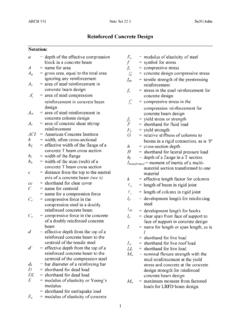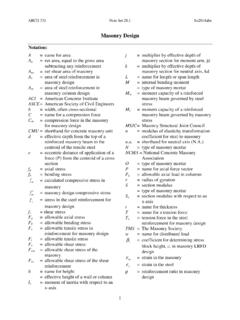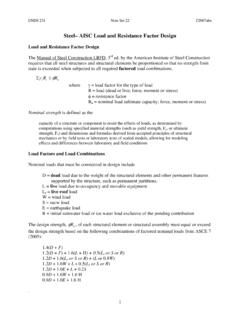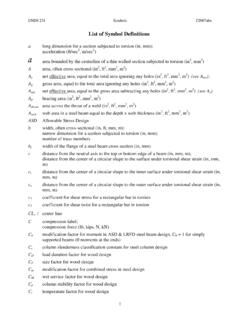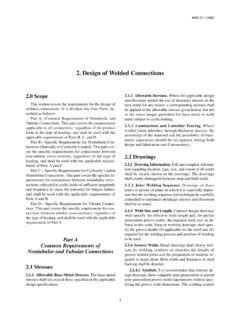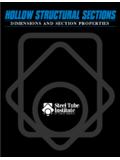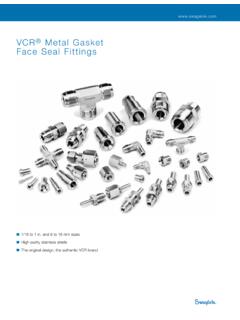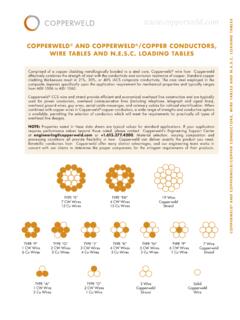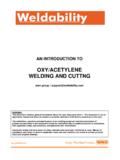Transcription of Connection and Tension Member Design - Texas A&M …
1 ARCH 631 Note Set F2013abn 1 Connection and Tension Member Design Notation: A = area (net = with holes, bearing = in contact, ) Ae = effective net area found from the product of the net area An by the shear lag factor U Ab = area of a bolt Ag = gross area, equal to the total area ignoring any holes Agv = gross area subjected to shear for block shear rupture An = net area, equal to the gross area subtracting any holes, as is Anet Ant = net area subjected to Tension for block shear rupture Anv = net area subjected to shear for block shear rupture ASD = allowable stress Design d = diameter of a hole fp = bearing stress (see P) ft = tensile stress fv = shear stress Fconnector = shear force capacity per connector Fn = nominal Tension or shear strength of a bolt Fu = ultimate stress prior to failure FEXX = yield strength of weld material Fy = yield strength Fyw = yield strength of web material g = gage spacing of staggered bolt holes I = moment of inertia with respect to neutral axis bending k = distance from outer face of W flange to the web toe of fillet l = name for length L = name for length Lc = clear distance between the edge of a hole and edge of next hole or edge of the connected steel plate in the direction of the load L = length of an angle in a connector with staggered holes LRFD = load and resistance factor Design n = number of connectors across a joint N = bearing length on a wide flange steel section = bearing type Connection with threads included in shear plane p = pitch of connector spacing P =
2 Name for axial force vector, as is T R = generic load quantity (force, shear, moment, etc.) for LRFD Design Ra = required strength (ASD) Rn = nominal value (capacity) to be multiplied by Ru = factored Design value for LRFD Design s = longitudinal center-to-center spacing of any two consecutive holes S = allowable strength per length of a weld for a given size SC = slip critical bolted Connection t = thickness of a hole or Member tw = thickness of web of wide flange T = throat size of a weld V = internal shear force Vlongitudinal = longitudinal shear force U = shear lag factor for steel Tension Member Design Ubs = reduction coefficient for block shear rupture X = bearing type Connection with threads excluded from the shear plane y = vertical distance = pi ( radians or 180 ) = resistance factor = diameter symbol = load factor in LRFD Design = safety factor for ASD = summation symbol ARCH 631 Note Set F2013abn 2 Connections Connections must be able to transfer any axial force, shear, or moment from Member to Member or from beam to column.
3 Steel construction accomplishes this with bolt and welds. Wood construction uses nails, bolts, shear plates, and split-ring connectors. Single Shear - forces cause only one shear drop across the bolt. Double Shear - forces cause two shear changes across the bolt. 2rPAPfv 222rPAPfv ARCH 631 Note Set F2013abn 3 pIVQnFareaconnectedconnector x y ya 4 2 2 12 8 p p p p p p Bearing of a Bolt on a Bolt Hole The bearing surface can be represented by projecting the cross section of the bolt hole on a plane (into a rectangle). Horizontal Shear in Composite Beams Typical connections needing to resist shear are plates with nails or rivets or bolts in composite sections or splices. The pitch (spacing) can be determined by the capacity in shear of the connector(s) to the shear flow over the spacing interval, p. where p = pitch length n = number of connectors connecting the connected area to the rest of the cross section F = force capacity in one connector Qconnected area = Aconnected area yconnected area yconnected area = distance from the centroid of the connected area to the neutral axis Connectors to Resist Horizontal Shear in Composite Beams Even vertical connectors have shear flow across them.
4 The spacing can be determined by the capacity in shear of the connector(s) to the shear flow over the spacing interval, p. tdPAPfp IVQpVallongitudin pIVQV allongitudin areaconnectedconnectorVQInFp ARCH 631 Note Set F2013abn 4 Tension Member Design In Tension members , there may be bolt holes that reduce the size of the cross section. Effective Net Area: The smallest effective are must be determined by subtracting the bolt hole areas. With staggered holes, the shortest length must be evaluated. A series of bolts can also transfer a portion of the tensile force, and some of the effective net areas see reduced stress. Connections in Wood Connections for wood are typically mechanical fasteners. Shear plates and split ring connectors are common in trusses. Bolts of metal bear on holes in wood, and nails rely on shear resistance transverse and parallel to the nail shaft. Bolted Joints Stress must be evaluated in the Member being connected using the load being transferred and the reduced cross section area called net area.
5 Bolt capacities are usually provided in tables and take into account the allowable shearing stress across the diameter for single and double shear, and the allowable bearing stress of the connected material based on the direction of the load with respect to the grain (parallel or perpendicular). Problems, such as ripping of the bolt hole at the end of the Member , are avoided by following code guidelines on minimum edge distances and spacing. eetATorAPf ARCH 631 Note Set F2013abn 5 Nailed Joints Because nails rely on shear resistance, a common problem when nailing is splitting of the wood at the end of the Member , which is a shear failure. Tables list the shear force capacity per unit length of embedment per nail. Jointed members used for beams will have shear stress across the connector, and the pitch spacing, p, can be determined from the shear stress equation when the capacity, F, is known. Other Connectors Screws - Range in sizes from #6 ( in.)
6 Shank diameter) to #24 ( in. shank diameter) in lengths up to five inches. Like nails, they are best used laterally loaded in side grain rather than in withdrawal from side grain. Withdrawal from end is not permitted. Lag screws (or bolts) Similar to wood screw, but has a head like a bolt. It must have a load hole drilled and inserted along with a washer. Split ring and shear plate connectors Grooves are cut in each piece of the wood members to be joined so that half the ring is in each section. The members are held together with a bolt concentric with the ring. Shear plate connectors have a central plate within the ring. Splice plates These are common in pre-manufactured joists and consist of a sheet of metal with punched spikes. Framing seats & anchors for instance, joist hangers and post Connections in Steel The limit state for connections depends on the loads: 1. Tension yielding 2. shear yielding 3.
7 Bearing yielding 4. bending yielding due to eccentric loads 5. rupture High strength bolts resist shear (primarily), while the connected part must resist yielding and rupture. Welds must resist shear stress. The Design strengths depend on the weld materials. ARCH 631 Note Set F2013abn 6 Bolted Connection Design Bolt designations signify material and type of Connection where SC: slip critical N: bearing-type Connection with bolt threads included in shear plane X: bearing-type Connection with bolt threads excluded from shear plane A307: similar in strength to A36 steel (also known as ordinary, common or unfinished bolts) A325: high strength bolts (Group A) A490: high strength bolts (higher than A325, Group B) Bearing-type Connection : no frictional resistance in the contact surfaces is assumed and slip between members occurs as the load is applied. (Load transfer through bolt only). Slip-critical connections: bolts are torqued to a high tensile stress in the shank, resulting in a clamping force on the connected parts.
8 (Shear resisted by clamping force). Requires inspections and is useful for structures seeing dynamic or fatigue loading. Class A indicates the faying (contact) surfaces are clean mill scale or adequate paint system, while Class B indicates blast cleaning or paint for = Bolts rarely fail in bearing. The material with the hole will more likely yield first. For the determination of the net area of a bolt hole the width is taken as 1/16 greater than the nominal dimension of the hole. Standard diameters for bolt holes are 1/16 larger than the bolt diameter. (This means the net width will be 1/8 larger than the bolt.) Design for Bolts in Bearing, Shear and Tension Available shear values are given by bolt type, diameter, and loading (Single or Double shear) in AISC manual tables. Available shear value for slip-critical connections are given for limit states of serviceability or strength by bolt type, hole type (standard, short-slotted, long-slotted or oversized), diameter, and loading.
9 Available Tension values are given by bolt type and diameter in AISC manual tables. Available bearing force values are given by bolt diameter, ultimate tensile strength, Fu, of the connected part, and thickness of the connected part in AISC manual tables. For shear OR Tension (same equation) in bolts: /RRna or nuRR where iiuRR single shear (or Tension ) bnnAFR double shear bnnAFR2 ARCH 631 Note Set F2013abn 7 where = the resistance factor Fn = the nominal Tension or shear strength of the bolt Ab = the cross section area of the bolt = (LRFD) = (ASD) A325, A325M F1858 A354 Grade BC A449 ARCH 631 Note Set F2013abn 8 For bearing of plate material at bolt holes: /RRna or nuRR where iiuRR deformation at bolt hole is a concern deformation at bolt hole is not a concern long slotted holes with the slot perpendicular to the load where Rn = the nominal bearing strength Fu = specified minimum tensile strength Lc = clear distance between the edges of the hole and the next hole or edge in the direction of the load d = nominal bolt diameter t = thickness of connected material = (LRFD) = (ASD) The minimum edge desistance from the center of the outer most bolt to the edge of a Member is generally 1 times the bolt diameter for the sheared edge and 1 times the bolt diameter for the rolled or gas cut edges.
10 The maximum edge distance should not exceed 12 times the thickness of thinner Member or 6 in. Standard bolt hole spacing is 3 in. with the minimum spacing of 232 times the diameter of the bolt, db. Common edge distance from the center of last hole to the edge is 1 ARCH 631 Note Set F2013abn 9 Tension Member Design In steel Tension members , there may be bolt holes that reduce the size of the cross section. g refers to the row spacing or gage p refers to the bolt spacing or pitch s refers to the longitudinal spacing of two consecutive holes Effective Net Area: The smallest effective are must be determined by subtracting the bolt hole areas. With staggered holes, the shortest length must be evaluated. A series of bolts can also transfer a portion of the tensile force, and some of the effective net areas see reduced stress. The effective net area, Ae, is determined from the net area, An, multiplied by a shear lag factor, U, which depends on the element type and Connection configuration.



